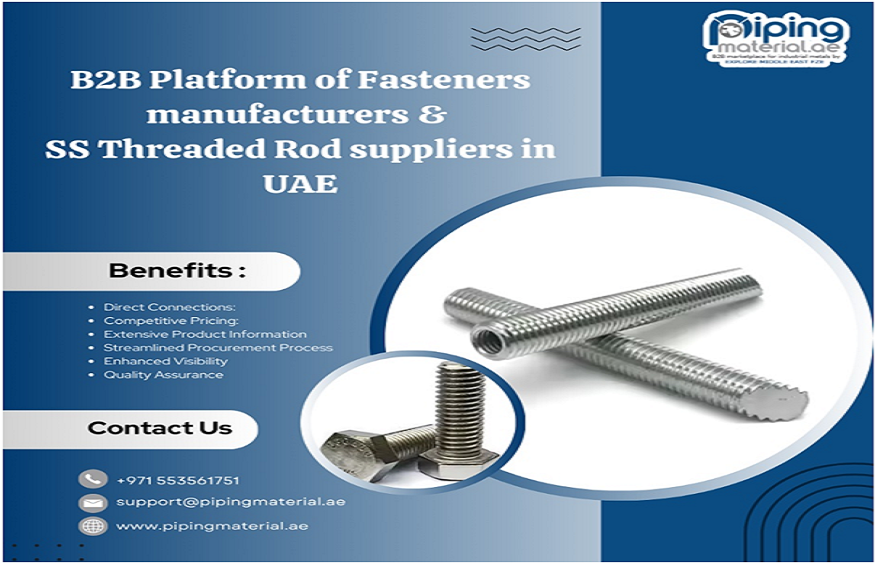Types of Fasteners and Threaded Rods: Manufacturing Techniques Explained

Pipingmaterial.ae is the B2B marketplace developed by Explore Middle East FZE. This is a unique concept where Buyers connect verified suppliers directly also get extensive information about piping products and Alloys. Anyone can refer to this for their technical queries about oil and gas piping materials as well as their properties and uses. Many of the engineers and Project managers come to pipingmaterial.ae for their day-to-day queries and also refer to their friends and colleagues. This concept is innovative and launched for the first time in the Middle east. The best part of this website that any user not only find trusted manufacturer or stockist of the steel pipe line products even get extensive and trustworthy technical data sheets of the products along with tips for buyers.
Pipingmaterialis a UAE based b2b platform and thousands of users visit it every day from Saudi Arabia, Qatar, Oman, Dubai and Mena countries.
At pipingmaterial dot ae anyone can find any kind of industrial steel products may be for agricultural, interior, home decor, medical and pharmaceutical industry like Corten steel, medical and surgical tubing
Here users can connect directly from genuine distributors and wholesalers and can get lowest price within their region.
Pipingmaterial dot ae is developed in latest technology and require many piping engineers, content writers and software developers, digital marketers for continuous development and enhancement
Many suppliers and stockist are joining and publishing their company details with original photos of their stocks and supplies from Abu Dhabi, India, muscat and Dubai. Each and every supplier is verified by team of piping material before posting his business on the website so the buyers can connect only with the genuine manufacturers.
Even the student of mechanical engineering and metallurgy refer this for weight chart, standards, sizes and welding process differences between 2 metals and alloys.
Types of Fasteners
Fasteners are widely used throughout many sectors with proven means for joining materials together reliably. Manufacturing fasteners has used a variety of techniques depending on the requirements of specific fasteners. Fasteners manufacturers in UAE employ several major manufacturing techniques to ensure that their products are high quality and deliver effectively in various applications.
1. Cold Heading
Cold heading is also widely used on fasteners, most commonly on bolts and screws. This process cuts a piece of metal wire into smaller pieces that are then fed into a heading machine. The metal there gets shaped under extreme pressure without the need for heat. This is advantageous for a number of reasons:
- Material Efficiency: Cold heading avoids waste as it uses nearly the entire volume of material.
- Strength: This is a process that strengthens the metal due to work hardening during the cold working process, and therefore the fasteners become stronger.
- Cost-Effectiveness: In many cases, this process costs less when producing large volumes of fasteners.
2. Thread Rolling
Thread rolling is the other important technique applied to make helical threads appearing on screws, bolts, and nuts. In this process, a cylindrical blank is positioned between two die plates that have an ideal profile of the thread. The dies rotate and press into the blank, thereby creating threads through pressure and rotation. The advantages of thread rolling are:
- Accuracy: The procedure yields highly accurate threads, ensuring a smooth fit between the rolled threads with the nuts or other bolts.
- Surface Finishing: In terms of surface finishing, thread rolling enhances the finish of the threads, which means a lower friction coefficient and wear at assembly time.
- Strength Increase: Material, like in cold heading, is strengthened through deformation, and the final product will always be robust.
3. Forging
A manufacturing process where the strong pressure at localized compressive regions usually provided with a hammer or a die creates the design in the metal. The method is employed significantly in the production of heavy-duty fasteners that include large bolts and screws. The following are the key benefits of forging:
- Improve Strength: Forging aligns the grain structure of the metal, thus providing it with the highest strength and great resistance to fatigue.
- Special Shapes: Fasteners can be designed with special shapes or features specifically designed to fulfil individual needs.
- Strength: Forged fasteners generally have more strength than fasteners manufactured using other processes.
4. Machining
Machining is the operation that removes material from a workpiece to obtain desired shape and dimensions. The process is mainly used when fasteners are in close tolerance or contain features that cannot be produced using other manufacturing processes. Machining offers:
- High Accuracy: This process allows for high tolerances and intricate designs, so the fasteners fit accurately in their intended application.
- Versatility: The manufacturers can provide a wide variety of fastener types and sizes; therefore, machining is ideal for specialty orders.
- Surface Coating: Machining also allows the introduction of surface treatments, like coatings, to enhance corrosion resistance.
5. Heat Treatment
Most fasteners are subjected to heat treatment following a preliminary manufacturing process enhances the mechanical properties. The fasteners are heated to certain temperatures and quenched rapidly so that the material solidifies within a short period. Advantages of heat treatment of fasteners include the following:
- Increased hardness: The fasteners become harder and more resistant to wear when stretched under stress.
- Improved toughness: The fasteners also acquire toughness if properly heat-treated, meaning there is minimal likelihood of a fastener failing under load.
- Tailored Properties: Depending upon the application need, the manufacturing house can tailor the heat treatment process to achieve any specific material characteristic.
Types of Threaded Rods
Stainless steel threaded rods are versatile fasteners used in construction, manufacturing, and many other industrial purposes. The threaded rods offer great strength and durability for a wide range of projects. Knowing about different varieties of SS threaded rods and the manufacturing method adopted by SS threaded rod manufacturers in UAE will help you choose the best product for your required applications.
Varieties of SS Threaded Rods
- Full Threaded Rods: Full threaded rods refer to a type of rod with a continuous thread through the entire length of the rod. That makes them applicable to a variety of applications since it is easy and straightforward to cut them to any required length and easily adjusted
- Applications: Applied widely in construction, anchoring systems, and mechanical assemblies where their grip is needed to be strong.
- Partially Threaded Rods: Partially threaded rods have a thread that only covers some part of the rod. This type of rod design provides an area that is smooth and may be used for applications where some area needs to be non-threaded.
- Applications: Most often used where a snug connection is needed at one end but attachment or alignment is to be allowed at the other end.
- Double threaded rods: Double threaded rods are made up of two different threaded sections and one smooth section in between. This design helps to gain the double strength of load capacity while also offering more flexibility in the type of installations.
- Uses: For applications that require multiple attachments or adjustment like in scaffolding or support structures.
- Threaded Rods with Different Thread Types: SS threaded rods could be threaded with various thread profiles. These profiles might be coarse and fine threads. Coarse threads are much easier to assemble and quick adjustments are provided, while fine threads give better tension control.
- Applications: The choice is made based on the application type. It may be either heavy-duty installation or the precise machinery.
Manufacturing Techniques Applied by SS Threaded Rod Suppliers in UAE
- Cold Heading: This is a cold heading of the metallic wire without using heat and gives it a shape as needed. The process works well during the making of a full or partial threaded rods which tend to offer notable strength together with adequate integrity.
- Advantages: This process prevents material wasting and produces a product that is always strong and possessed excellent mechanical properties
- Thread Rolling: During thread rolling, a cylindrical blank is placed in between two dies that have the required thread profile. Two dies rotate and press against the blank for the formation of threads without material removal.
- Advantages: The threads produced are very accurate and are of high quality with an improved surface finish and better performance.
- Machining: Machining involves cutting, drilling, or forming metals into some specific dimensions. This process is primarily applied to special-application threaded rods or rods with special requests.
- Advantages: This process can offer tight tolerances and complex designs whereby the rods are said to have fully met the required specifications.
- Heat Treatment: Thermal surface treatment improves the properties of stainless steel threaded rods. This indeed involves heating the bar to high temperatures followed by quenching to achieve required hardness and toughness.
- Advantages: Heat treatment strengthens and toughens the mechanical strength of rods against wear resistance by suitable high-stress applications.
- Surface Finishing: Surface finishing techniques in the forms of passivation, coating, or polishing are applied to the stainless steel threaded rods to increase corrosion and aesthetic properties.
- Advantages: Such surface treatment increases the lifespan of threaded rods and enhances their performance in diverse environments.
Conclusion
Looking at the foregoing discussion, it would be helpful knowing the types of fasteners and types of threaded rods in choosing the right components for construction and engineering projects. Partnering with fasteners manufacturers and threaded rod suppliers in UAE will ensure businesses can guarantee compliance with industry standards and to receive the tested and proven-to-be safe and reliable products for such projects. Strategic sourcing improves the quality of the project and generally aids operations on a whole.






